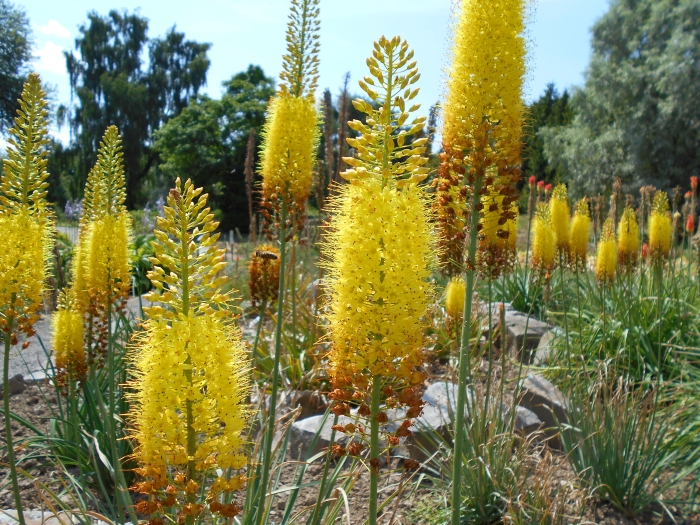Narrow-Leaved Foxtail Lily
(Eremurus stenophyllus)
Narrow-Leaved Foxtail Lily (Eremurus stenophyllus)
/
/

Salicyna
CC BY-SA 4.0
Image By:
Salicyna
Recorded By:
Copyright:
CC BY-SA 4.0
Copyright Notice:
Photo by: Salicyna | License Type: CC BY-SA 4.0 | License URL: https://creativecommons.org/licenses/by-sa/4.0 | Uploader: Salicyna | Publisher: Wikimedia Commons | Title: Eremurus_stenophyllus_2015-07-01_3762.jpg | Notes: {{Information |Description={{en|1=Closeup of the flowers of the Rabbitbrush in [[:File:CrestonePostOffice.JPG]] of the variety of [[:Em:Chrysothamnus nauseosus|Chrysothamnus nauseosus]] used for [[:En:xeriscaping|xeriscaping]] post office in [[:En |

























Estimated Native Range
Summary
Eremurus stenophyllus, commonly known as Narrow-Leaved Foxtail Lily, is a deciduous perennial bulb native to semi-desert regions and stony slopes in Central Asia. It reaches up to 1 meter (3.3 feet) in height, with a similar spread, and features narrow, strap-shaped leaves. The plant produces striking racemes of small, star-shaped yellow flowers in early to mid-summer, which create a dramatic display as they darken to brown from the base with age, resulting in a two-tone effect. The flower spikes can be quite showy and add vertical interest to the garden.
The Narrow-Leaved Foxtail Lily is valued for its unique flower spikes and is often used in sunny borders and gravel gardens. It has earned the Royal Horticultural Society’s Award of Garden Merit, indicating its excellence for garden use. While it is hardy down to −20 °C (−4 °F), it benefits from the shelter of a wall in colder climates. This plant thrives in full sun and requires well-drained soil, preferably sandy or loamy, with moderate watering. It is important to avoid waterlogged conditions, especially in winter, as the bulbs can rot. After flowering, the plant goes dormant, and the foliage dies back. It is generally low maintenance but can be affected by slugs and snails when young.CC BY-SA 4.0
The Narrow-Leaved Foxtail Lily is valued for its unique flower spikes and is often used in sunny borders and gravel gardens. It has earned the Royal Horticultural Society’s Award of Garden Merit, indicating its excellence for garden use. While it is hardy down to −20 °C (−4 °F), it benefits from the shelter of a wall in colder climates. This plant thrives in full sun and requires well-drained soil, preferably sandy or loamy, with moderate watering. It is important to avoid waterlogged conditions, especially in winter, as the bulbs can rot. After flowering, the plant goes dormant, and the foliage dies back. It is generally low maintenance but can be affected by slugs and snails when young.CC BY-SA 4.0
Plant Description
- Plant Type: Bulb
- Height: 3-5 feet
- Width: 1-2 feet
- Growth Rate: Moderate
- Flower Color: Yellow
- Flowering Season: Summer
- Leaf Retention: Deciduous
Growth Requirements
- Sun: Full Sun
- Water: Medium
- Drainage: Medium, Fast
Common Uses
Drought Tolerant, Fragrant, Low Maintenance, Rock Garden, Showy Flowers
Natural Habitat
Semi-desert regions and stony slopes in Central Asia
Other Names
Common Names: Gul Stäpplilja, Afghanistan-Steppenkerze
Scientific Names: , Eremurus stenophyllus, Ammolirion stenophyllum, Henningia stenophylla,
GBIF Accepted Name: Eremurus stenophyllus (Boiss. & Buhse) Baker